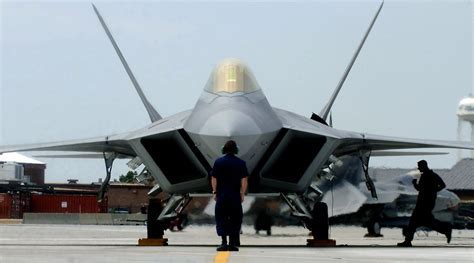
Once hailed as the pinnacle of U.S. air superiority, the F-22 Raptor’s unmatched capabilities in speed, stealth, and supermaneuverability are now being re-evaluated in an era where geopolitical tensions and technological advancements have evolved rapidly.

With the emergence of fifth-generation fighters from rivals such as Russia, and the U.S. itself considering the ushering in of a sixth-generation jet, the F-22 finds itself in a complex situation.

The F-22 Raptor was introduced with the promise of unparalleled air dominance, a testament to its Cold War genesis aimed at outclassing the Soviet Union’s fighters in dogfights.

However, the decision to halt production in 2009, influenced by then-President Obama and Secretary of Defense Robert Gates, reflected a shift in priorities to the War on Terror and a judgment that the Raptor’s role against insurgencies was minimal.

The once-envisioned fleet of 750 Raptors was reduced to 187 operational units, a cutback that has sparked debate among analysts and military enthusiasts alike.

Barack Obama’s statement that he rejected “the notion that we have to waste billions of taxpayer dollars on outdated and unnecessary defense projects to keep this nation secure” now resurfaces amidst current global tensions.

Russia’s Sukhoi Su-57 have narrowed the gap in air superiority that the U.S. once comfortably held.

Despite the introduction of the F-35 Lightning II, which boasts superior radar technology and network-centric warfare capabilities, it falls short in certain aspects when compared to the Raptor, notably in stealth and dogfighting prowess.

In terms of armament, the fighter can carry air-to-air and air-to-ground weapons, such as the Joint Direct Attack Munitions and precision-guided ground bombs.

Moreover, the F-22 can transport six AIM-120 AMRAAMS and two AIM-9 Sidewinders in its air-to-air configuration.

The possibility of reviving F-22 production, however, faces steep obstacles. With the original production lines shut down, estimates suggest that restarting manufacturing could cost upwards of $50 billion for just 194 new units, creating a financial barrier that is difficult to overcome.

Moreover, the F-22 has faced challenges, including maintenance complexity for its stealth coatings and oxygen system issues.

These operational difficulties, coupled with the high costs, have led to a fleet that is often less than 100 jets flying at any given time.

While the stealth fighter has had its share of challenges, supporters of the jet have ample data to back their argument.

Though financial concerns could halt an F-22 line restart, reports from 2017 suggest more challenging obstacles: retrieving the necessary tooling proved to be a significant challenge. Ultimately, even if the Air Force desired a restart, it might be impractical without substantial investments in both time and money.
articles:
– The F-22 Fighter Has 1 Problem That Is Impossible to Fix, The National Interest
– Why the Air Force Can’t Build Anymore F-22 Raptor Stealth Fighters, nationalinterest.org
– The F-22 Raptor Has 1 Problem: No Enemy Worth Fighting, The National Interest
– Is The F-22 Raptor Really Unbeatable?, Simple Flying
